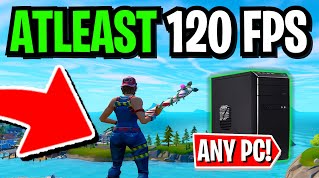If we compare PC gaming to console gaming, then it is not that simple. It’s more of a plug-and-play than a plug-and-play. The landscape of gaming is ever-evolving and to give a competitive edge you need a system with the right configuration and a great FPS.
Whenever we talk about gaming, frames per second or FPS is the most talked about topic. But why is it so? Well, when FPS is high, makes the gaming experience immersive and offers unparalleled responsiveness with visual fluidity.

If you have the right software optimization and the right hardware, then attaining 120 FPS on your Windows PC is not a big deal. So here let’s understand what things you need to optimize to maximize your gaming performance.
Right configurations for optimized gaming
Frame rate refers to the individual frames or images that are displayed every second. It impacts the responsiveness and speed of gameplay. Mostly the traditional monitor will operate at 60 Hz, but the new monitors have a high refresh rate and are capable of rendering up to 120 Hz or 240 Hz.
240 Hz has gained quite popularity among gamers because of its smooth visuals. So let’s learn about hardware, software, and monitor optimization we need to do to achieve a better gaming experience.
Software Consideration
To achieve the optimal performance of a PC while playing games, we need the best software as it works like a backbone of the system. Here are the changes and pointers we need to keep in mind.
Optimization tools and game mode
Nowadays modern GPUs have inbuilt optimization tools like AMD Radeon software or NVIDIA’s GeForce Experience that provide features like performance monitoring, game mode, and one-click optimization. By utilizing these tools one can streamline their gaming experience and be rest assured that their hardware is performing at its peak.
Overclocking
For gaming enthusiast who wants to push the hardware to the maximum limit, overclocking can unleash the additional performance that you are expecting from your GPU and CPU. But be cautious because when you do overclocking, it comes with an inherent risk that may cause harm to the system if not done properly. It is better to research the safe techniques of overclocking for the specific hardware, and then proceed cautiously to avoid any hardware damage or stability issues.
Driver updates
If the GPU drivers are updated, it will optimize the performance and ensure great compatibility with the latest version of the games. Both AMD and Nvidia release their driver updates regularly that help to improve performance, optimize the game, and fix bugs. Make it a habit to update regularly or install them to maximize gaming performance.
Graphic settings
By fine-tuning the graphics settings, one can bring a huge impact on the frame rate without compromising on the visual quality. Adjust the settings like shadow resolution, texture, quality, ambiance, and occlusion to find the perfect balance between visual and performance. Try to disable the effects which are resource intensive like motion blurness or field’s depth.
Graphics Card
To achieve a high frame rate one requires good GPU capabilities. It is recommended to opt for a powerful graphics card like AMD or Nvidia who are reputed manufacturers. These have high VRAM along with great processing power that is needed for handling high-demand modern games. Try to opt for NVIDIA’s GeForce RTX series or AMD’s Radeon RX series which offers amazing performance.
Hardware Considerations
Hardware is the thing that you need to consider first while purchasing any system. To achieve 120 FPS we need a robust hardware system. Here are the key things to look out for.
Storage
Though not directly connected to the frame rate if you have an SSD or solid-state drive in your system, then it will reduce the load time and help in improving the overall responsiveness of the system thereby enhancing the gaming experience. It is better to invest in a fast storage solution like NVMe SSD that comes with lightning-fast read and write speed. It will make the process of loading large game files less laggy.
Memory
For a great gaming experience sufficient RAM is a crucial factor. It helps the system to cache frequently the assessed data and handle multitasking with ease. If you are configuring a gaming laptop then try to have at least 16GB of high-speed DDR4 RAM as it will help in preventing memory-related slowdown and will ensure optimal performance.
Processor
GPU indeed plays a pivotal role in gaming laptops but CPU is also necessary for maintaining high frame rates when you are in a scenario having numerous AI entities or playing CPU-intensive games. Try to pick a modern CPU having multiple cores with high clock speed like AMD’s Ryzen 7 series or Intel Core i7 for high performance without damaging your system.
Monitor Consideration
Once the software and hardware parts are sorted, we need the best monitor to be able to support the 120 FPS. Here’s what you have to look for.
Refresh Rate
If you want to appreciate your 120 FPS gameplay completely, you need a monitor capable of rendering 120 Hz. It is better to look for gaming monitors that have high refresh rates with lower response times as it will reduce the motion blurness and input lagging, thereby enhancing the overall gaming experience and fluidity.
Resolution: A system with high resolution will offer sharp visuals but will also need more GPU horsepower to be able to maintain the high frame rate. So consider reducing the resolution to 1080p or 1440p if it is getting difficult for you to achieve 120 FPS consistently while playing fast-paced games.
Variable Refresh Rate: Technologies like AMD FreeSync and NVIDIA G-SYNC, help to synchronize the GPU’s frame rate with the monitor’s refresh rate to reduce the screen stuttering or tearing and to provide a smooth gaming experience. If the monitor supports VRR, then you need to go to the control panel of the GPU and enable it to enhance the game’s fluidity further.
Final Words
These are the prime factors that you need to keep in mind while optimizing your system to enhance gaming performance. To achieve 120 FPS on a PC, you need the right combination of monitor, software, and hardware optimization.
Try to invest in high-performance components, find the right settings, and leverage features like variable refresh rate and overclocking to unlock the full potential of the PC. Once the configurations are correct and everything is fine, then it will offer smooth gameplay
